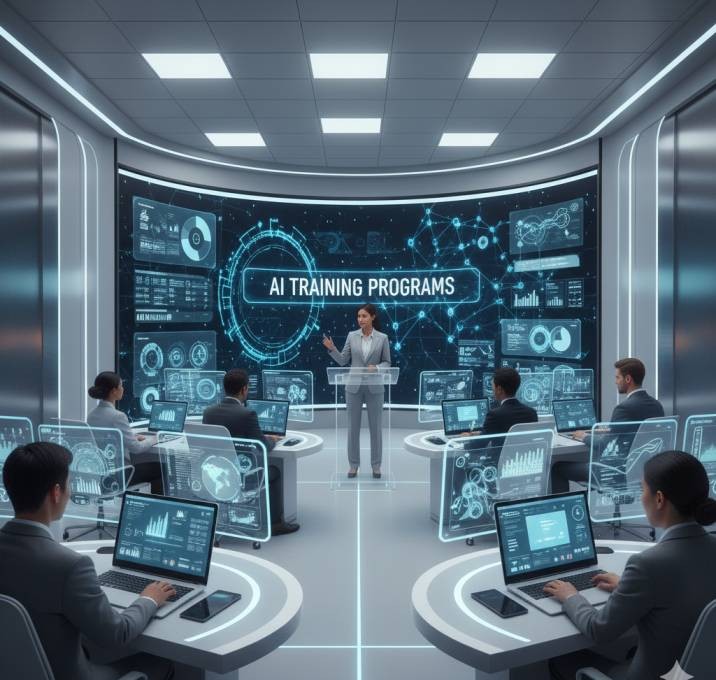AI in Cloud- Architect Insights
As 2025 arrives, cloud architecture is set to become a fundamental component of cloud computing rather than just an additional feature. Cloud architects will emphasize the integration of AI across all infrastructure levels, facilitating automation, predictive analytics, personalized experiences, and enhanced security.
Key trends include pervasive AI, AI-powered edge computing, AI-driven security, low-code/no-code AI platforms, multi-cloud optimization for AI, and robust ethical AI governance.
Apart from this, there are many aspects of AI in cloud architecture that remain untapped. In this blog, we will focus on key aspects and the impact on cloud architecture.
Let’s begin!
Key aspects of AI in Cloud Architecture for 2025
1. AI-Enhanced Cloud Services
Cloud providers are integrating AI capabilities directly into their services. This goes beyond simply offering AI/ML platforms; it means AI is used “under the hood” to improve the performance and management of the cloud itself. This could include:
- Workload Optimization: Cloud platforms analyze application behavior in real-time and automatically adjust resources (CPU, memory, storage) to meet demand, minimizing over-provisioning and reducing costs. Imagine a website experiencing a sudden surge in traffic; the cloud automatically scales up resources to handle the load and then scales back down when traffic subsides.
- Resource Allocation: AI can predict future resource needs based on historical data and usage patterns. This allows for proactive allocation, preventing performance bottlenecks and optimizing resource utilization. For instance, the cloud might predict a spike in database queries at the end of the month and pre-allocate additional database instances.
- Anomaly Detection: AI algorithms monitor system logs and metrics to identify unusual patterns that could indicate a problem, such as a security breach or a hardware failure. A sudden spike in failed login attempts or an unusual pattern of network traffic could trigger an alert.
- Predictive Maintenance: Cloud providers use AI to predict when hardware components are likely to fail, allowing for proactive maintenance and preventing downtime. This could involve analyzing disk drive performance metrics to predict potential failures.
Increased efficiency, reduced costs, improved reliability, and simplified management.
2. Edge Computing with AI
Processing data closer to the source (the “edge” of the network) using AI models. This is crucial for applications where latency is a major concern. This might include:
- IoT: A smart factory uses edge devices with embedded AI to analyze sensor data in real-time, detecting anomalies in equipment performance and triggering maintenance alerts before a breakdown occurs.
- Autonomous Vehicles: Self-driving cars rely on edge computing with AI to process sensor data (cameras, lidar, radar) in real-time, making split-second decisions about navigation and obstacle avoidance.
- Industrial Automation: Robots on a production line use edge-based AI to perform quality control checks, identifying defects in products in real-time and adjusting manufacturing processes.
This helps in reduced latency, improved real-time decision-making, increased privacy (data is processed locally), and reduced bandwidth usage. Requires careful design of distributed AI systems and efficient model deployment at the edge.
3. AI-Driven Security
Using machine learning to enhance security by detecting and responding to cyber threats.
- Intrusion Detection: AI algorithms analyze network traffic and system logs to identify malicious activity, such as malware infections or data breaches.
- Fraud Detection: AI systems analyze financial transactions in real-time to detect fraudulent activity, such as unauthorized credit card use.
- Phishing Detection: AI models can analyze emails and websites to identify phishing attempts, warning users about potentially malicious content.
This results in improved threat detection, faster incident response, and enhanced security posture. Crucial for protecting cloud environments from increasingly sophisticated cyberattacks.
4. Democratization of AI
Making AI development accessible to a wider range of users, including those without deep expertise in machine learning.
- Low-Code/No-Code AI Platforms: Cloud providers offer platforms that provide visual interfaces and pre-built components, allowing developers to build AI applications without writing complex code. Drag-and-drop interfaces and automated machine learning (AutoML) tools simplify the process.
- Pre-trained Models: Cloud providers offer pre-trained AI models for common tasks like image recognition, natural language processing, and sentiment analysis. Developers can use these models directly or fine-tune them for specific applications.
It helps in increased adoption of AI, faster development cycles, and empowerment of citizen developers.
5. Multi-Cloud Optimization for AI
Designing AI systems that can run across multiple cloud providers to optimize performance, cost, and availability.
- A company might use one cloud provider for data storage, another for model training, and a third for deployment, choosing the best platform for each task.
- A company might distribute its AI workloads across multiple clouds to avoid vendor lock-in and increase resilience.
This helps with increased flexibility, reduced costs, improved performance, and enhanced resilience. Requires careful planning and management of data and model deployment across different cloud environments.
6. AI-Powered Data Pipelines
Building efficient data pipelines to support the training and deployment of AI models.
- Automated Data Ingestion: AI can be used to automate the process of collecting data from various sources, cleaning and transforming it, and loading it into a data warehouse.
- Feature Engineering: AI algorithms can be used to automatically identify and extract relevant features from data, which can improve the accuracy of AI models.
The impact seems positive with faster data processing, improved data quality, and more efficient model training. Essential for building robust and scalable AI systems.
7. Ethical AI Considerations
Addressing the ethical implications of AI, including bias, fairness, transparency, and accountability.
- Bias Detection and Mitigation: Cloud providers offer tools and services to detect and mitigate bias in AI models, ensuring that they are fair and equitable.
- Explainable AI (XAI): Techniques that make AI models more transparent and understandable, allowing users to see how the model arrived at its decisions.
- Responsible AI Frameworks: Cloud providers are developing frameworks and guidelines to help organizations build and deploy AI systems responsibly.
This results in increased trust in AI systems, reduced risk of harmful outcomes, and greater social responsibility. A critical consideration for the long-term success of AI.
Impact on Cloud Architects
1. Skill Development
Cloud Architects traditionally focused on infrastructure, networking, and application deployment. The rise of AI requires them to expand their skillset significantly. This includes:
- AI Fundamentals: Architects need a solid understanding of core AI concepts. This isn’t about becoming AI researchers, but about understanding the principles behind:
- Machine Learning (ML): Knowing different ML algorithms (supervised, unsupervised, reinforcement learning), their strengths and weaknesses, and when to apply them. Example: Understanding the difference between linear regression and a decision tree, and when one is more appropriate for a given problem.
- Deep Learning (DL): Grasping the basics of neural networks, different architectures (CNNs, RNNs), and their applications. Example: Knowing that Convolutional Neural Networks (CNNs) are often used for image recognition.
- Natural Language Processing (NLP): Familiarity with techniques for processing and understanding human language. Example: Understanding how sentiment analysis works or how chatbots are built.
- AI Service Integration: Cloud providers offer a wide range of AI services. Architects must know how to leverage these:
- Pre-trained Models: Understanding how to use readily available models for tasks like image classification, object detection, or language translation. Example: Using a cloud provider’s pre-trained model for identifying objects in images uploaded by users.
- Custom Model Deployment: Knowing how to deploy and scale custom-trained ML models on the cloud. Example: Deploying a model trained to predict customer churn using a cloud platform’s machine learning services.
- AI Platform Management: Understanding the tools and services for managing the lifecycle of AI models, including training, versioning, and monitoring. Example: Using a cloud platform’s MLflow or similar tool for managing different versions of a model and tracking their performance.
- Cloud-Native AI: Architects must be able to design cloud architectures optimized for AI workloads. This includes:
- GPU Optimization: Understanding how to leverage GPUs for accelerated model training and inference. Example: Configuring virtual machines with GPUs for training deep learning models.
- Scalability and Performance: Designing systems that can handle the computational demands of AI applications. Example: Using Kubernetes to orchestrate and scale AI workloads.
- Cost Optimization: Understanding the cost implications of different AI services and infrastructure choices. Example: Choosing the most cost-effective GPU instance type for a given training task.
2. Focus on Data Strategy
AI is data-driven. Cloud architects must become experts in data strategy to support AI initiatives:
- Data Acquisition and Ingestion: Understanding how to collect data from various sources and ingest it into the cloud. Example: Setting up data pipelines to ingest data from IoT devices, social media feeds, and databases.
- Data Storage and Management: Choosing the right storage solutions for different types of data used in AI. Example: Using object storage for unstructured data like images and videos, and relational databases for structured data.
- Data Governance and Security: Ensuring data quality, privacy, and security. Example: Implementing data access control policies and anonymization techniques.
- Data Preparation and Feature Engineering: Understanding the importance of data preprocessing and feature engineering for building effective AI models. Example: Using data transformation techniques to clean and prepare data for model training.
- Data Discovery and Cataloging: Making data easily discoverable and accessible to data scientists. Example: Implementing a data catalog to track and document data assets.
3. Collaboration with Data Scientists
Building AI solutions requires strong collaboration between cloud architects and data scientists:
- Understanding Data Scientists’ Needs: Architects need to understand the specific requirements of data scientists, such as the types of tools and frameworks they use, the computational resources they need, and the data formats they prefer. Example: Knowing that data scientists often use Python and libraries like TensorFlow and PyTorch.
- Facilitating Model Development: Architects can help data scientists by providing them with the necessary infrastructure and tools for model training and experimentation. Example: Setting up Jupyter notebooks on the cloud for data scientists to develop and test models.
- Model Deployment and Integration: Architects play a crucial role in deploying trained models into production environments and integrating them with other applications. Example: Working with data scientists to containerize models using Docker and deploy them using Kubernetes.
- Communication and Collaboration: Effective communication and collaboration are essential for successful AI projects. Architects and data scientists need to work closely together to ensure that the technical infrastructure supports the AI objectives. Example: Participating in joint design sessions to discuss the architecture of AI solutions.
Conclusively, we can say that cloud architects need to prioritize AI integration, mastering skills in AI fundamentals, data strategy, and collaboration with data scientists. This shift enables automated, intelligent cloud services, driving innovation and efficiency while addressing ethical considerations.
If you want to update yourself with the latest AI technology in cloud architecture, consider checking out AI+ Architecture certification and lead the way. Enroll now!
Recent Blogs

FEATURED
AI Training Programs for Educators: How to Become an Authorized Training Partner
October 31, 2025
FEATURED
Designing Scalable AI Training Programs for Global Delivery
October 31, 2025
FEATURED
Role of AI Training Programs in Upskilling Non-Tech Professionals
October 31, 2025
FEATURED
Top Features to Look for When Partnering on AI Training Programs
October 31, 2025
FEATURED
Why AI Training Programs Are Becoming the Global Standard
October 30, 2025

